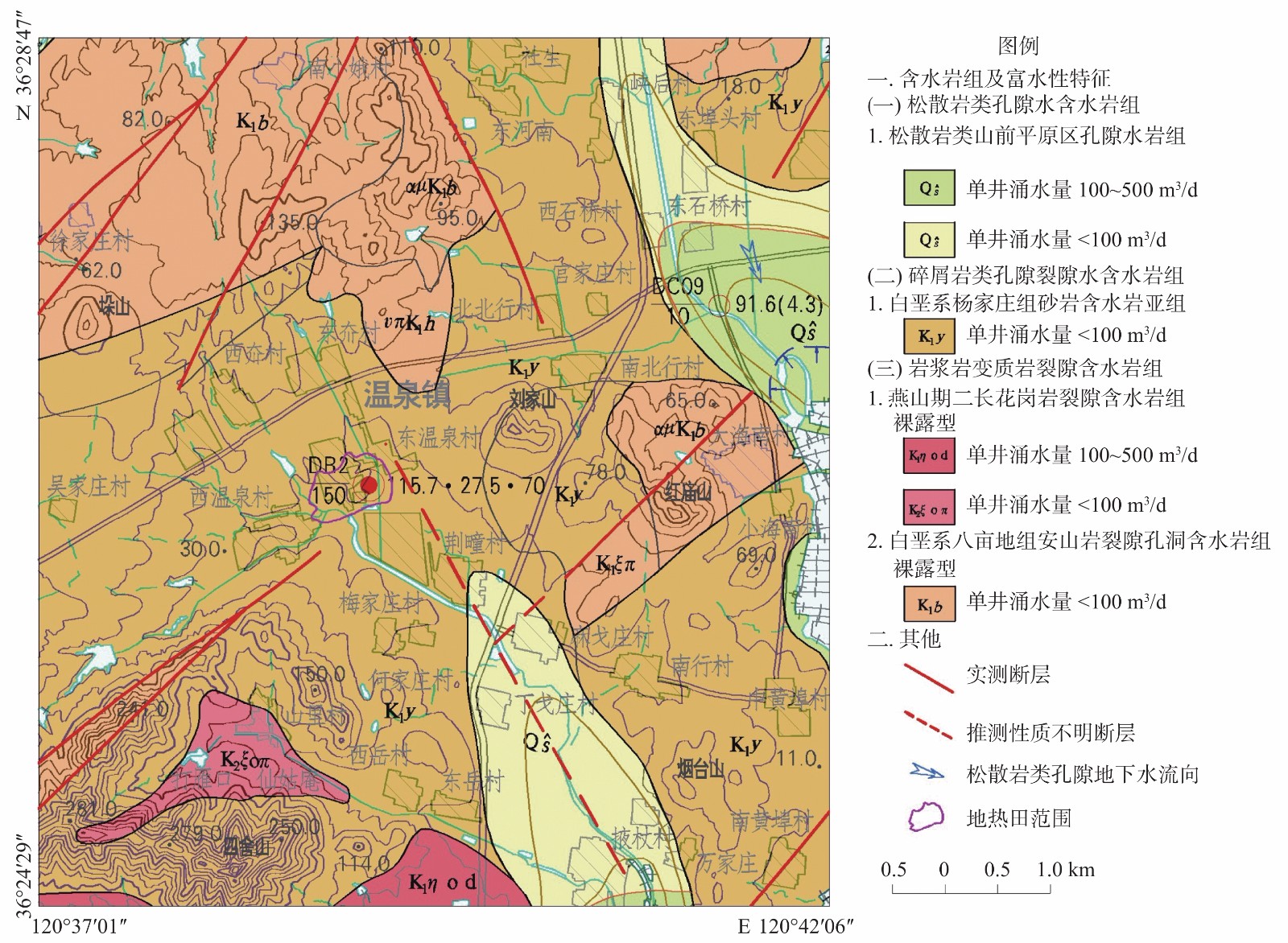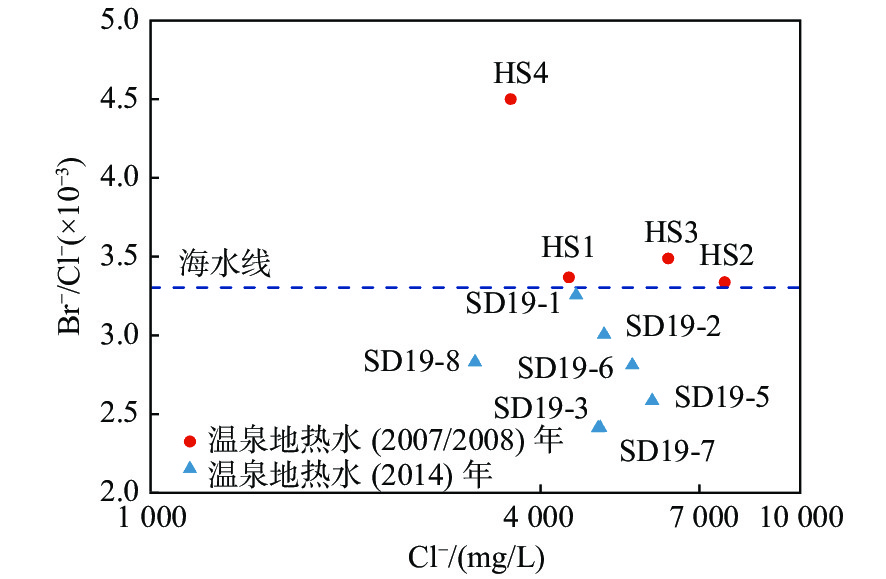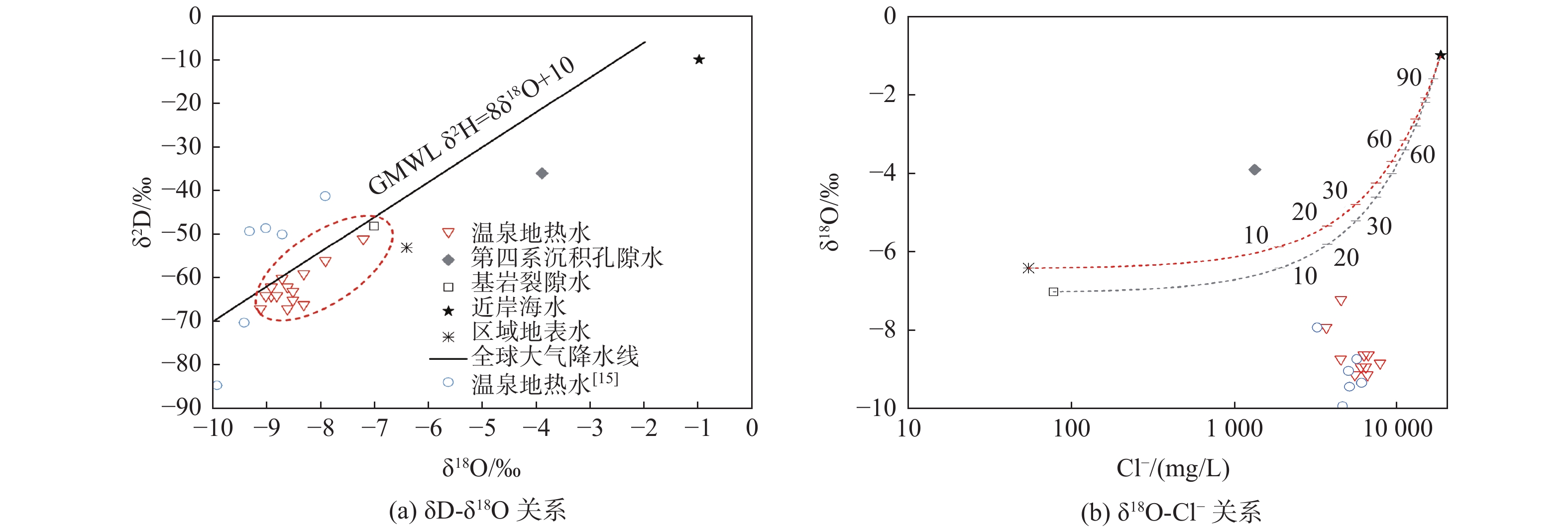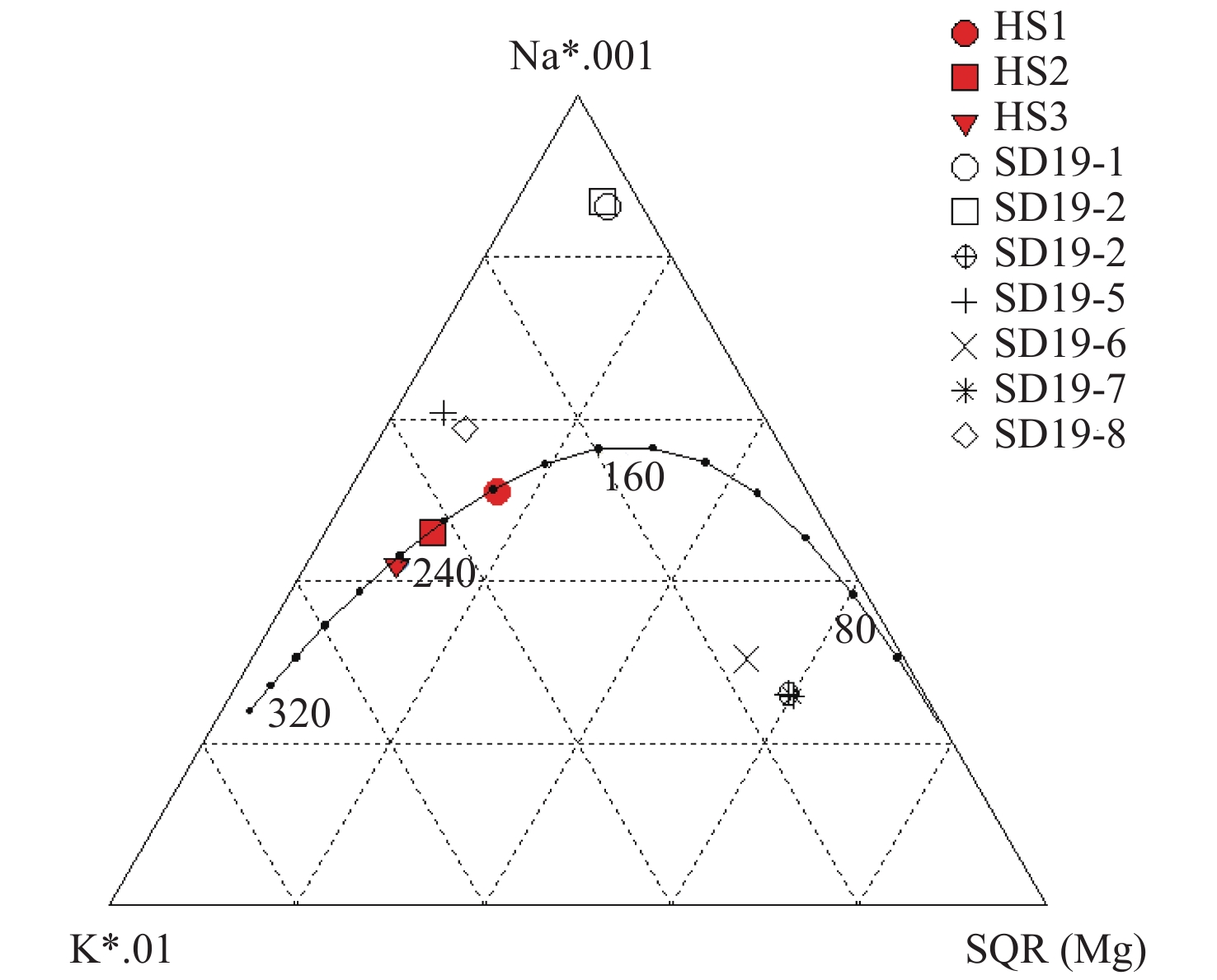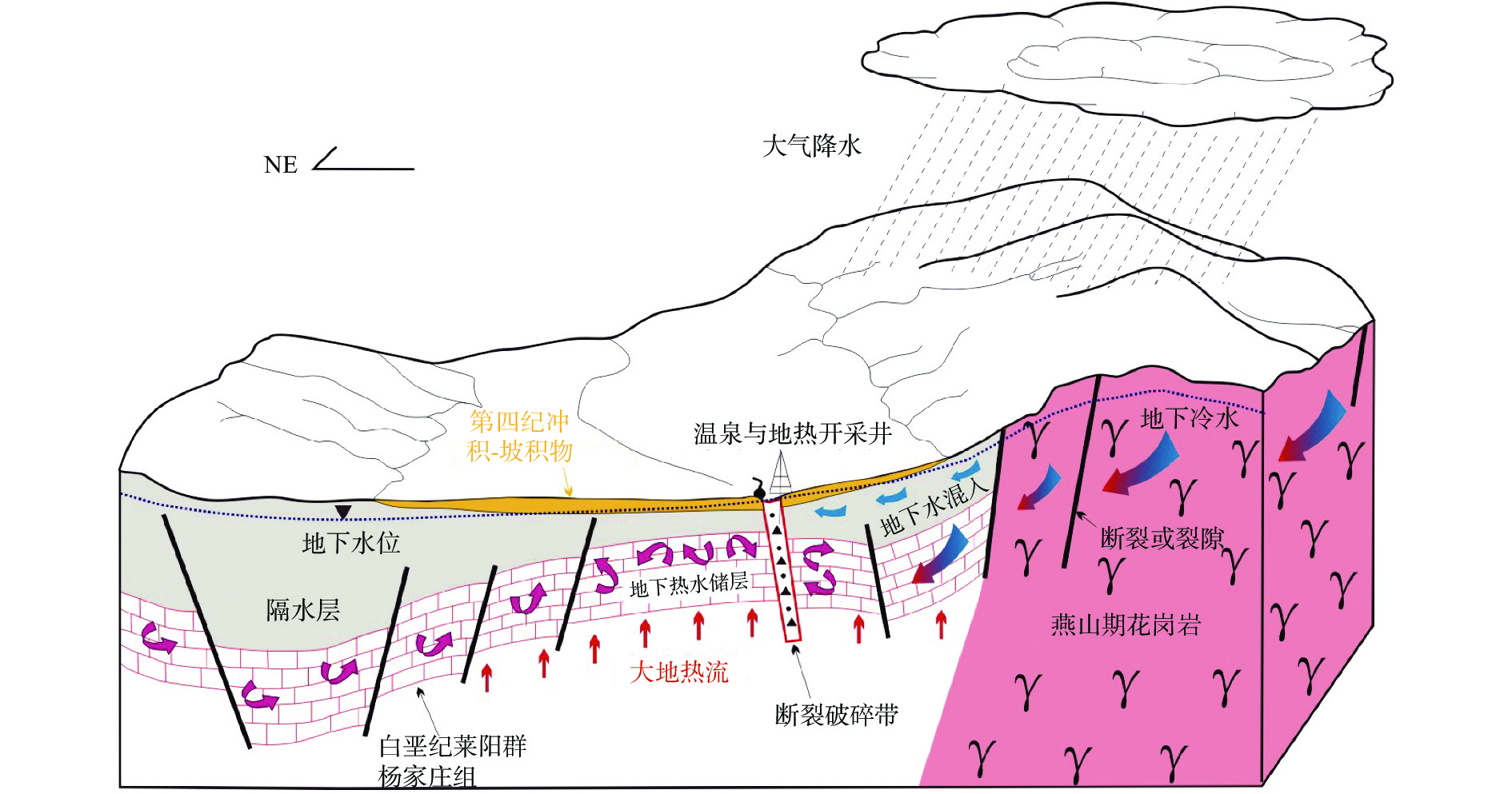STUDIES ON HYDROCHEMICAL CHARACTERISTICS AND FORMING MECHANISMS OF JIMO HOT SPRING GEOTHERMAL FIELD
-
摘要:
即墨温泉地热是青岛地区的特色矿产资源,已成为当地经济发展的重要生长点。然而由于长期的大量开采,地热水供需矛盾、环境等问题日益突出。通过对比分析不同年份和季节即墨温泉地热水的化学组分与同位素特征,并结合地热资源调查资料和围岩地球化学与区域地质构造特征,探讨分析即墨温泉地热水的组成变化和成因机制。研究结果表明:即墨温泉是在独特的构造部位和良好的储水条件下,由大气降水补给并经过深部循环,由大地热流和深部热交换等作用加热,并通过水岩反应淋滤盐分,最终形成矿化度较高的地下热水并沿断裂上升出露地表。随着开采量的持续上升,温泉地热区水循环速率明显增加,地热水中的Na+和Cl−等主要成分以及氢氧同位素组成在不同补给来源的多端元混合以及水岩相互作用下表现出较为显著的差异,部分地热含水层受到浅层地下水混入的影响。因此,应积极探索建立长时间序列的年际和年代际标准化水质连续观测计划,并通过水化学指标变化的模拟,为温泉地热资源的开发和管理提供科学指导。
Abstract:The Jimo geothermal hot spring is an important pillar for local economy in the Qingdao region for years. The supply of hot water has gradually become insufficient with time, and many environment problems have appeared. In this paper, upon the basis of the study of regional geological background, hydrochemical and isotopic compositions of the geothermal water from the Jimo Hot Spring were systematically analyzed for the years of 2007, 2008 and 2014, in addition to the geochemistry of surrounding rocks. The research results show that the Jimo hot spring owes its origin to the unique structural conditions and excellent water storage conditions. Water is recharged from atmospheric precipitation. It goes to the deep where it is heated by deep crustal heat flow. Due to over-extraction of hot water since last decade, the geothermal water circulation rate of the hot spring has accelerated significantly. The main ions components such as Na+and Cl−, as well as the hydrogen and oxygen isotope compositions, show quite significant differences caused by multi-endmember mixing and water-rock interaction. In order to improve the management of the hot spring, it is suggested that long-term seasonal and interannual observations and hydrochemical simulation be established to provide scientific monitoring for the development and management of hot spring and geothermal resources.
-
Key words:
- geothermal water /
- hydro-geochemistry /
- forming mechanism /
- Jimo Hot-spring
-

-
表 1 水样采样点及其氢氧同位素分析结果
Table 1. Sampling locations and hydrogen and oxygen isotopic composition of water samples
取水点编号 取水地点 水样类型 水样位置 取样日期 水温/℃ δ18O /‰ δD /‰ 经度(E) 纬度(N) HS1 青岛温泉度假村地热井 地热水 120°39′9.1″ 36°26′35.2″ 2007.4.13 83 −8.7 −60 2007.9.15 80 −8.6 −62 2008.4.23 82 −9.1 −67 2008.9.8 78 −8.5 −65 HS2 东温泉村温泉浴池地热井 地热水 120°39′7.9″ 36°26′36.2″ 2007.4.13 85 −8.8 −64 2007.9.15 78 −8.6 −67 2008.4.23 82 −9.0 −64 2008.9.8 75 −8.3 −59 HS3 工人疗养院地热井 地热水 120°39′11.0″ 36°26′36.7″ 2007.4.13 85 −8.9 −62 2007.9.15 80 −8.9 −64 2008.4.23 84 −9.1 −67 2008.9.8 79 −8.5 −63 HS4 金麒玉麟温泉山庄地热井 地热水 120°39′15.7″ 36°26′37.6″ 2007.4.13 85 −7.9 −56 2007.9.15 80 −8.3 −66 HS5 顺兴浴池地热井 地热水 120°39′7.68″ 36°26′30.3″ 2014 - −7.3 −52 HS6 温泉一路南新兴街东水井 松散沉积物水 120°39′25.5″ 36°26′42.9″ 2014 - −3.8 −35 HS7 何家村东北水井 基岩裂隙水 120°39′25.5″ 36°26′17.4″ 2014 - −6 −49 HS8 东温泉村西水塘 地表水 120°38′44.5″ 36°26′39.3″ 2007.4.13 - −3.9 −35 2007.9.15 - −6.4 −53 2008.4.23 - −8.0 −59 2008.9.8 - −7.4 −55 SW1 温泉大坝外侧 海水 120°43′32.7″ 36°26′7.9″ 2007.4.13 −0.4 −7 2007.9.15 −1.0 −10 2008.4.23 - −0.3 −8 表 2 即墨温泉地热水主要离子和元素组成与矿化度
Table 2. Ion composition and mineralization of Jimo Hot-spring geothermal water
编号 Na+/(mg/L) K+/(mg/L) Ca2+/(mg/L) Mg2+/(mg/L) Cl−/(mg/L) SO42−/(mg/L) HCO3−/(mg/L) Br−/(mg/L) 矿化度/(g/L) HS1* 1 831 118.8 689.4 0.33 4 396 299.1 − 14.82 11.1 HS2* 2 302 212.9 990.8 0.33 7 625 103.4 − 25.45 10.1 HS3* 2 410 277.9 1001 0.31 6 246 95.19 − 21.81 11.6 HS4* 1 635 135 689.7 − 3 581 268.7 − 16.11 6.3 HS5* 1 942 − 791 − 4 412 268 51 − 7.7 HS6* 545 − 470 − 1 314 621 55 − 3.0 HS7* 54 − 87 − 78 98 90 − 0.43 HS8* 34 2.3 39.8 − 55 0.81 − − 0.13 SW1* 8 493 337.7 385.9 − 17 900 2 081 − 59.19 32.4 SD19-1** 1 910 8.24 918 <0.05 4 510 168 50 14.7 7.6 SD19-2** 2 090 9.27 1 000 <0.05 4 980 151 17.1 15 8.4 SD19-3** 2 240 124 1 060 26 4 875 670 4.78 11.8 9.0 SD19-5** 2 540 142 1 100 <0.05 5 900 139 22 15.3 9.8 SD19-6** 2 380 131 1 120 17.1 5 500 435 10.7 15.5 9.6 SD19-7** 2 160 118 1 030 25.3 4 910 557 1.2 11.9 8.8 SD19-8** 1 540 85.3 578 <0.05 3 155 161 76.4 8.95 5.6 注:*HS1-HS3、HS8的数据为2007年和2008年4次测试数据的平均值,HS4的数据为2007年2次测试数据的平均值,HS5~HS7的数据为2014年测试值,SW1的数据为2007年和2008年3次测试数据的平均值,**数据来源于文献[15]。 表 3 即墨温泉主要离子比值与氢氧同位素组成特征
Table 3. Ion ratios and isotopic characteristics of Jimo hot spring geothermal water
编号 Br−/Cl−(×10−3) γNa+/γCl− δ18O /‰ δD /‰ 水样类型 采样时间 HS1* 3.37 0.42 −8.73 −63.5 温泉地热水 2007 HS2* 3.34 0.30 −8.68 −63.5 温泉地热水 2007 HS3* 3.49 0.39 −8.85 −64 温泉地热水 2007 HS4* 4.50 0.46 −8.1 −61 温泉地热水 2007 HS5 − 0.68 −7.3 −52 温泉地热水 2014 SD19-1 3.26 0.65 −9.9 −84.4 温泉地热水 2014 SD19-2 3.01 0.65 −9.4 −70.1 温泉地热水 2014 SD19-3 2.42 0.71 − − 温泉地热水 2014 SD19-5 2.59 0.66 −9.3 −49.2 温泉地热水 2014 SD19-6 2.82 0.67 −8.7 −49.9 温泉地热水 2014 SD19-7 2.42 0.68 −9 −48.5 温泉地热水 2014 SD19-8 2.84 0.75 −7.9 −41.2 温泉地热水 2014 HS6 0.00 0.64 −3.8 −35 第四系松散沉积物水 2014 HS7 0.00 1.07 −6 −49 基岩裂隙水 2014 HS8* 0.00 0.95 −6.43 −50.5 地表水 2007 SW1* 3.31 0.73 −0.57 −8.3 海水 2007 *HS1-HS3、HS8的数据为2007年和2008年4次测试数据的平均值,HS4的数据为2007年2次测试数据的平均值,SW1数据为2007年和2008年3次测试数据的平均值。 表 4 即墨温泉地热热储温度的计算结果
Table 4. Temperature calculation results for geothermal reservoir of Jimo hot spring
编号 Na/K 热储温度(Na-K)/℃ 热储温度*(SiO2)/℃ pH 水温/℃ HS1 15.4 167 − − 83 HS2 10.8 201 − 7.0 85 HS3 8.7 225 − 6.9 85 HS4 12.11 190 − − 85 SD19-3 18.06 153 120.9 6.2 63 SD19-5 17.89 154 123.0 6.9 70 SD19-6 18.17 152 110.4 5.7 60 SD19-7 18.31 151 113.3 5.4 63 SD19-8 18.05 153 105.6 7.2 60 注:*数据来源于文献[15] -
[1] BERTANI R. World geothermal generation in 2007[C]//Proceedings European Geothermal Congress, Unterhaching, Germany, 2007: 1-11.
[2] GLASSLEY W E. Geothermal energy: renewable energy and the environment[M]. Boca Raton: CRC Press, 2010.
[3] 蔺文静,刘志明,王婉丽,等. 中国地热资源及其潜力评估[J]. 中国地质,2013,40(1):312-321. doi: 10.3969/j.issn.1000-3657.2013.01.021
[4] NEMZER M, PAGE D. Geothermal Energy[M]. 1994, 29(1): 92.
[5] 张锐. 海螺沟温泉的水文地球化学特征及成因研究[D]. 四川: 成都理工大学, 2017.
[6] 高宗军,吴立进,曹红. 山东省地热资源及其开发利用[J]. 山东科技大学学报(自然科学版),2009,28(2):1-7.
[7] 刘焱光,曹秀云,付云霞,等. 即墨温泉地热水水质的动态变化特征[J]. 山东国土资源,2010,26(2):19-24. doi: 10.3969/j.issn.1672-6979.2010.02.005
[8] 栾光忠,李桂群. 胶东温泉地质地热背景及其控泉构造[J]. 青岛海洋学报,1993,23(1):75-58.
[9] 刘焱光,付云霞,吴世迎. 即墨温泉地热水的氢氧同位素特征及其地质意义[J]. 海岸工程,2009,28(2):52-60. doi: 10.3969/j.issn.1002-3682.2009.02.007
[10] 栾光忠,张海平. 青岛沧口-温泉断裂的空间展布及现代活动性研究[J]. 地震地质,2001,23(1):63-68.
[11] 栾光忠,王文正,刘东生,等. 青岛即墨温泉喷流沉积物及其沉积模式[J]. 地球学报,2003,24(4):357-360. doi: 10.3321/j.issn:1006-3021.2003.04.012
[12] 金秉福,张云吉,栾光忠. 胶东温泉的地热特征[J]. 西安工程学院学报,2000,22(1):54-58.
[13] 王桂玲,尹明泉,张日田. 采用水化学方法对青岛北部地区资源远景的探讨[J]. 山东地质,2003,19(2):46-50.
[14] 徐锐,董杰,曹立雪,等. 山东即墨温泉资源开发利用与可开采水量评价[J]. 地质学报,2019,93(s1):206-211.
[15] 王昕昀. 山东半岛西部温泉水化学特征及成因研究[D]. 北京: 中国地质大学(北京), 2018.
[16] 李乃胜. 崂山地质与古冰川研究[M]. 北京: 海洋出版社, 2005.
[17] 山东省地矿工程集团有限公司. 《山东省即墨市温泉镇地区地热资源普查报告》[R]. 济南, 2006.
[18] 周训, 金晓媚, 梁四海, 等. 地下水科学专论[M]. 北京: 地质出版社, 2017.
[19] 熊贵耀,付腾飞,韩江波,等. 大沽河流域地下水水化学及同位素特征[J]. 海洋科学进展,2019,37(4):626-638.
[20] 杨吉龙,柳富田,贾志,等. 河北牛驼镇与天津地热田水化学和氢氧同位素特征及其环境指示意义[J]. 地球学报,2018,39(1):71-78. doi: 10.3975/cagsb.2017.122801
[21] 赵永红,杨家英,王航,等. 地热水氢氧同位素分布特性[J]. 地球物理学进展,2017,32(6):2415-2423. doi: 10.6038/pg20170618
[22] 汪洋. 应用大地热流和地下流体氦同位素组成资料计算中国大陆地壳生热元素丰度[J]. 中国地质,2006,33(4):920-927. doi: 10.3969/j.issn.1000-3657.2006.04.022
[23] PEIFFER L,WANNER C,SPYCHER N,et al. Optimized multicomponent vs. classical geothermometry:Insights from modeling studies at the dixie valley geothermal area[J]. Geothermics,2014,51:154-169. doi: 10.1016/j.geothermics.2013.12.002
[24] 李洁祥,郭清海,余正艳. 高温地热系统中黏土矿物形成对Na-K和K-Mg地球化学温标准确性的影响[J]. 地球科学,2017,42(1):142-154.
[25] 王欣,漆继红,许模,等. Na-K-Mg三角图修正与Na-K温标选取[J]. 煤田地质与勘探,2019,47(2):121-128.
[26] ARNORSSON S,GUNNLAUGSSON E,SVAVARSSON H. The chemistry of geothermal waters in Iceland 2:Mineral equilibria and independent variables controlling water compositions[J]. Geochimica et Cosmochimica Acta,1983,47(3):547-566. doi: 10.1016/0016-7037(83)90277-6
[27] 山东省第三地质矿产勘查院. 《山东省胶东半岛深部地热赋存条件研究报告》[R]. 烟台, 2015.
-



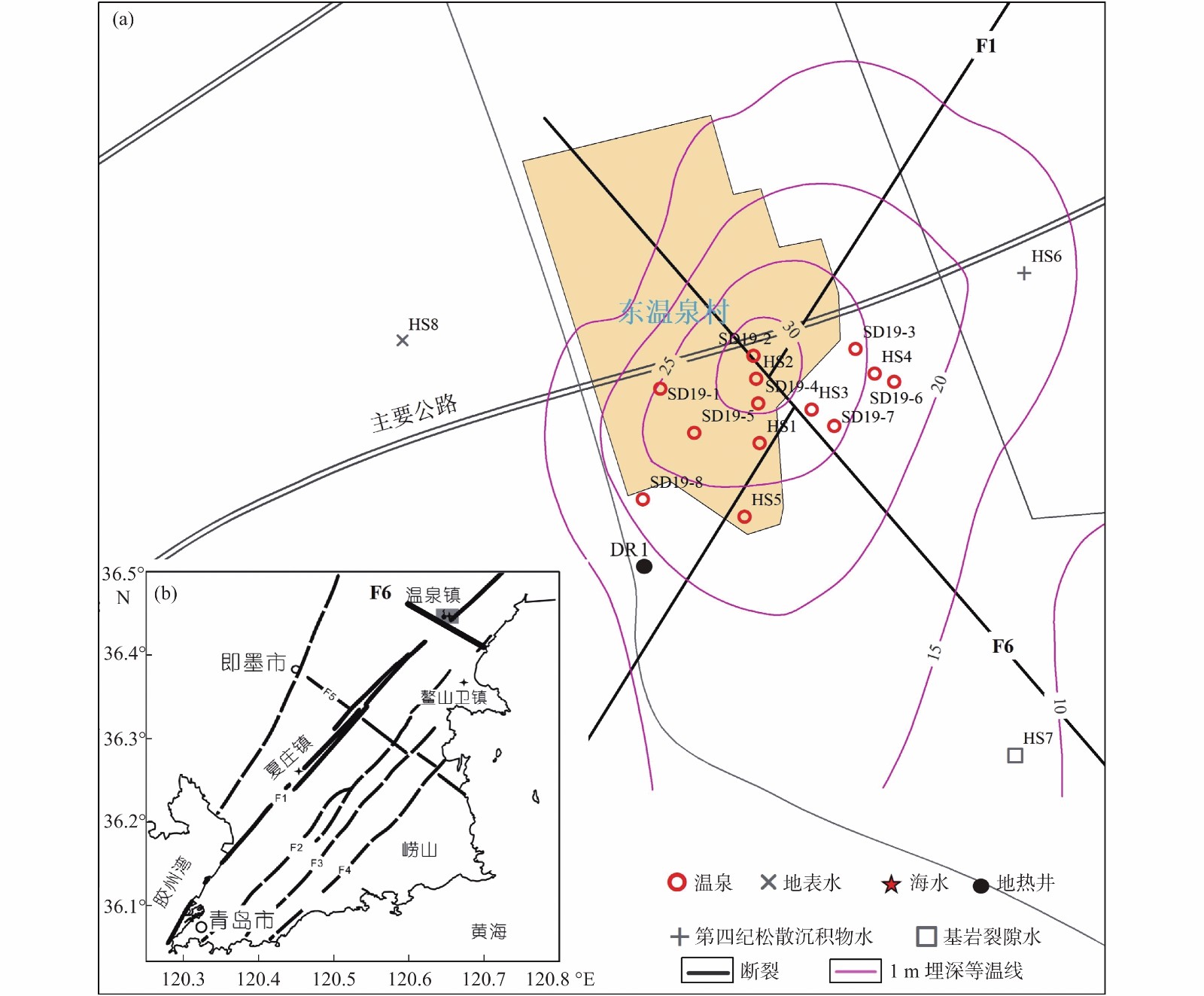
 下载:
下载:
